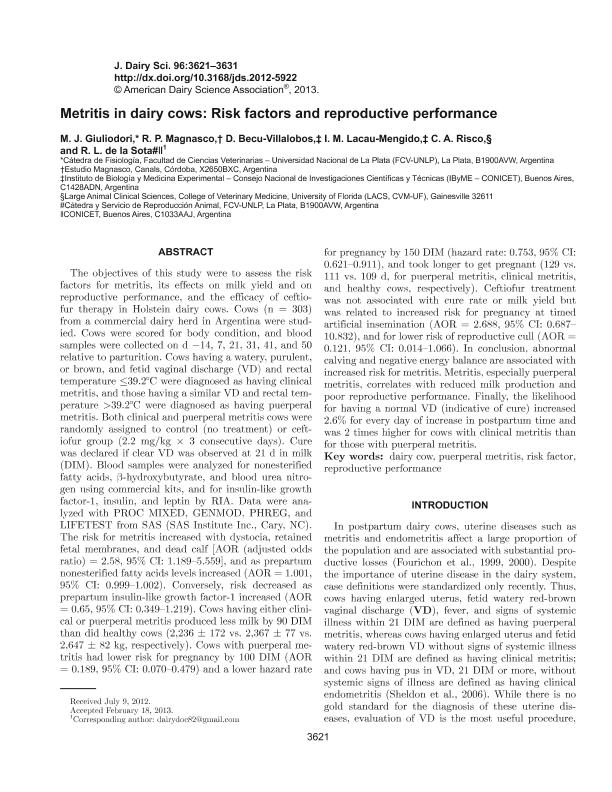Mostrar el registro sencillo del ítem
dc.contributor.author
Giuliodori, M. J.
dc.contributor.author
Magnasco, R. P.
dc.contributor.author
Becu, Damasia

dc.contributor.author
Lacau, Isabel Maria

dc.contributor.author
Risco, C. A.
dc.contributor.author
de la Sota, Rodolfo Luzbel

dc.date.available
2016-09-19T20:12:04Z
dc.date.issued
2013-03-30
dc.identifier.citation
Giuliodori, M. J.; Magnasco, R. P.; Becu, Damasia; Lacau, Isabel Maria; Risco, C. A.; et al.; Metritis in dairy cows: risk factors and reproductive performance; Amer Dairy Science Assoc-adsa; Journal Of Dairy Science; 96; 30-3-2013; 3621-3631
dc.identifier.issn
0022-0302
dc.identifier.uri
http://hdl.handle.net/11336/7668
dc.description.abstract
The objectives of this study were to assess the risk factors for metritis, its effects on milk yield and on reproductive efficiency, and the efficacy of ceftiofur therapy in Holstein dairy cows. Cows (N = 303) from a commercial dairy herd in Argentina were studied. Cows were body condition scored and tail bled on days -14, 7, 21, 31, 41 and 50 relative to parturition. Cows having a watery, purulent or brown-colored, fetid vaginal discharge (VD) and rectal temperature <39.1ºC were diagnosed as having clinical metritis, and those having a similar VD and rectal temperature ≥ 39.1ºC were diagnosed as having puerperal metritis. Both, clinical and puerperal metritis cows were randomly assigned to control (no treatment) or ceftiofur group (2.2 mg/kg x 3 consecutive days). Cure was declared if clear VD was observed 21 days in milk (DIM). Blood samples were analyzed for non‐esterified fatty acids, -hydroxy butyric acid and blood urea nitrogen using commercial kits and insulin-like growth factor-1, insulin, and leptin by RIA. Data were analyzed with PROC MIXED, GENMOD, PHREG and LIFETEST from SAS. The risk for metritis increased with abnormal calving (AOR [adjusted odds ratio] = 2.58, 95% CI = 1.189 to 5.559, P = 0.008), and as prepartum NEFA levels increased (AOR = 1.001, 95% CI = 0.999 to 1.002, P = 0.177). Conversely, risk decreased as prepartum IGF-1 increased (AOR = 0.65, 95% CI = 0.349 to 1.219, P = 0.144). Cows having both, clinical and puerperal metritis produced less milk by 90 DIM than the normal cows (2,236 172 vs. 2,367 77 vs. 2,647 82 kg, respectively, P = 0.009). Cows with puerperal metritis had lower risk for pregnancy by 100 DIM (AOR = 0.189, 95% CI = 0.070 ? 0.479, P = 0.014), lower hazard rate for pregnancy by 150 DIM (0.753, 95% CI = 0.621 to 0.911, P = 0.014), and took longer to get pregnant (129 vs. 111 vs. 109 days, for puerperal metritis, clinical metritis and normal cows, respectively, P = 0.015). Ceftiofur had neither effect on cure rate nor on milk yield but increased the risk for TAI (AOR = 2.126, 95% CI = 0.983 to 4.597, P = 0.055) and for pregnancy at TAI (AOR = 2.688, 95% CI = 0.687 to 10.832, P = 0.142), and reduced the risk for reproductive cull (AOR = 0.121, 95% CI = 0.014 to 1.066, P = 0.057). In conclusion, abnormal calving and negative energy balance increase the risk for metritis. Metritis, especially the puerperal one, reduces both, milk production and reproductive efficiency. Finally, the likelihood for having a normal vaginal discharge (indicative of cure) increases 2.6 % for every day of increase in postpartum time and is 2 times higher for cows with clinical metritis than for those with puerperal metritis.
dc.format
application/pdf
dc.language.iso
eng
dc.publisher
Amer Dairy Science Assoc-adsa

dc.rights
info:eu-repo/semantics/openAccess
dc.rights.uri
https://creativecommons.org/licenses/by-nc-sa/2.5/ar/
dc.subject
Dairy Cows
dc.subject
Metritis
dc.subject
Risk Factors
dc.subject
Reproductive Performances
dc.subject
Anti Bacterial Agents
dc.subject
Cattle
dc.subject.classification
Ciencias Veterinarias

dc.subject.classification
Ciencias Veterinarias

dc.subject.classification
CIENCIAS AGRÍCOLAS

dc.subject.classification
Producción Animal y Lechería

dc.subject.classification
Producción Animal y Lechería

dc.subject.classification
CIENCIAS AGRÍCOLAS

dc.title
Metritis in dairy cows: risk factors and reproductive performance
dc.type
info:eu-repo/semantics/article
dc.type
info:ar-repo/semantics/artículo
dc.type
info:eu-repo/semantics/publishedVersion
dc.date.updated
2016-05-10T13:45:50Z
dc.journal.volume
96
dc.journal.pagination
3621-3631
dc.journal.pais
Estados Unidos

dc.journal.ciudad
Illinois
dc.description.fil
Fil: Giuliodori, M. J.. Universidad Nacional de La Plata. Facultad de Ciencias Veterinarias; Argentina
dc.description.fil
Fil: Magnasco, R. P.. Estudio Magnasco; Argentina
dc.description.fil
Fil: Becu, Damasia. Consejo Nacional de Investigaciones Científicas y Técnicas. Instituto de Biología y Medicina Experimental (i); Argentina
dc.description.fil
Fil: Lacau, Isabel Maria. Consejo Nacional de Investigaciones Científicas y Técnicas. Instituto de Biología y Medicina Experimental (i); Argentina
dc.description.fil
Fil: Risco, C. A.. University Of Florida; Estados Unidos
dc.description.fil
Fil: de la Sota, Rodolfo Luzbel. Universidad Nacional de la Plata. Facultad de Cs.veterinarias. Instituto de Teriogenologia. Catedra de Reproduccion Animal; Argentina
dc.journal.title
Journal Of Dairy Science

dc.relation.alternativeid
info:eu-repo/semantics/altIdentifier/doi/http://dx.doi.org/10.3168/jds.2012-5922
dc.relation.alternativeid
info:eu-repo/semantics/altIdentifier/pmid/23548288
dc.relation.alternativeid
info:eu-repo/semantics/altIdentifier/url/http://www.journalofdairyscience.org/article/S0022-0302(13)00234-8/abstract
dc.relation.alternativeid
info:eu-repo/semantics/altIdentifier/url/http://www.journalofdairyscience.org/article/S0022-0302(13)00234-8/abstract
Archivos asociados
